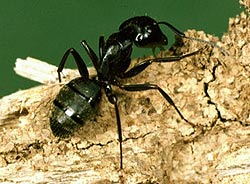RENEGADE GARDENER™
The lone voice of horticultural reason
“Wood mulch attracts carpenter ants”
 This is an oft-quoted and widely circulated myth of urban legend proportions. Judging from my e-mails this season, it once again is gaining steam as it passes, mouth-to-mouth, around the country. It is false.
This is an oft-quoted and widely circulated myth of urban legend proportions. Judging from my e-mails this season, it once again is gaining steam as it passes, mouth-to-mouth, around the country. It is false.
First off, know that a nice, thick layer of shredded bark or wood chips around your home is not a banquet spread out for the pleasure and convenience of carpenter ants. Carpenter ants don’t eat wood, a simple fact that surprises many (do carpenters eat wood?). Carpenter ants can bore through solid wood, however, and do so for the sole purpose of building a nest. They will nest in live and dead trees, and fresh or rotting logs and stumps. And since a telephone pole, fence or porch post, or the wood frame of your house, look and act a lot like dead trees to them, they will sometimes build their nests in these man-made structures.
But the wood mulch on your property, including the wood mulch around the home, doesn’t in any way attract or draw them in. Homes surrounded by lawn, dirt, cocoa bean or pecan husks, “decorative” rock (with or without black plastic), or faded Astroturf have just as good a chance of hosting carpenter ant nesting activity as any surrounded by wood mulch. Wood mulch is not food for them, nor is it in any way suitable nesting material. These are facts corroborated by the many university experts and professional exterminators with which I’ve conversed.
We have a lot of trees surrounding our homes in Minnesota. Also wood piles, stumps, and rotting logs. So we have carpenter ants, like the rest of the nation. The best thing you can do to keep carpenter ants from nesting in your home is keep the woodpile as far from the house as possible. Clear fallen trees and logs out from near the house, also. Have stumps ground out fully anytime you fell a tree.
If you see carpenter ants near or in the home, you need to find and eradicate the nest. Just remember that wood chips and/or shredded bark, if present, had nothing to do with the infestation. One expert with whom I spoke is conducting research to support his theory that black plastic under “decorative” rock is more of an attractant to carpenter ants, since the soil under the plastic stays dry, and is easier for ants to navigate. You can imagine my delight if that proves true.
The Virginia Tech Extension Service has a decent little primer on carpenter ants at:
pubs.ext.vt.edu/3104/3104-1573/3104-1573.html
Don Engebretson
The Renegade Gardener